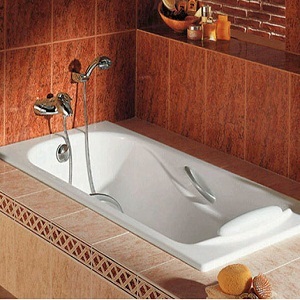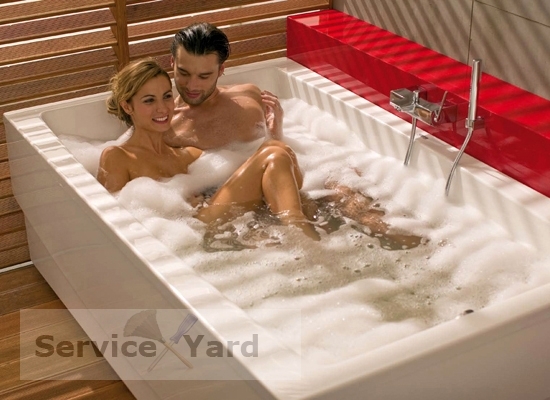
- What are the baths?
- How can I whiten a cast iron bath?
- How to whiten a cast-iron bath with enamel coating?
- How can I bleach an acrylic bath?
- Useful advices
The bathroom is one of the important places in the house. Here, purity, beauty and, most importantly, a good mood for the whole day are born. But often it spoils the contemplation of the consequences of the old water supply, the sludge of low-quality water, why the question arises - how to whiten the old bath from all this "beauty" in the form of a rust and lime. In this article we will share with you some tricks so that you can quickly and easily achieve a crystal whiteness of the bath, remove the roughness and wash the yellowness.
to the contents ↑What are the baths?
 Before starting to clean the bowl, specify which material it was made from. Each type requires an individual approach.
Before starting to clean the bowl, specify which material it was made from. Each type requires an individual approach.
There are several types of baths:
- cast iron;
- metal;
- plastic;
- with acrylic coating.
Important! Most often installed in modern apartments and private houses cast iron and acrylic bowls, as they are more durable, attractive, but at the same time they keep the heat perfectly and do not create noise discomfort during water intake or showering.
to the contents ↑How can I cast a cast iron bath?
Do you have a cast-iron bath of "not the first youth", covered with small cracks and a yellow coating of water due to hard water? If you want to restore its original appeal, you will need such tools:
- sponge on one side with a hard surface;
- cleaning powder;
- bleach on a chlorine base;
- citric acid;
- oxalic acid;
- vinegar;
- soda;
- means against rust;
- solvent;
- sandpaper.
How to whiten an old cast iron bath?
We offer you several effective ways to clean the cast-iron bath. Choose the easiest and least expensive for you and take it to your note for regular cleaning.
Method 1
If you have old plumbing and you are not afraid that it might deteriorate, use abrasive scouring powders and an iron bristle brush:
- Remove the rust with a brush.
- Rinse the tub.
- Apply oxalic acid, diluted with water in the form of gruel. This tool is considered less aggressive than others.
- Leave the mixture on rusty stains for 30-40 minutes.
- Rinse with water.
Method 2
This method is considered the most economical and more aggressive:
- Wet the tub.
- Spray an abrasive cleaner over the entire surface of the bath.
- Leave for a while, allow to soak.
- Places, with accumulation of plaque, handle more intensively with an iron brush.
- Rinse with clean water.
Method 3
Use the most versatile tool - baking soda. It is used to whiten even the most stale spots and rust on the plumbing:
- Dilute the calcined and baking soda in a ratio of 1: 1, the amount of powder depends on the area of the surface being cleaned.
- Apply the mixture and leave for 5 minutes.
- Make a solution of bleach and vinegar, pour the surface of the bath for another 2 hours.
- Rinse well with running water.
Method 4
Use products on a cream base, they have more gentle abrasive substances. This method is suitable for newer plumbing:
- Apply cream-gel to the sponge.
- Thoroughly treat the inside of the bowl with the substance.
- Wait a few minutes.
- Rinse off with plenty of water.
Method 5
Clean the tub of old dirt will help you modern means, such as: CIF, Mr. Muscle, Sanox, San Wedge, Domestos. Use them this way:
- Moisten the wall of the bathtub so that the solution completely covers the surface, and does not fall into thin streaks.
- Leave for a while, depending on the surface contamination.
- Clean sponge thoroughly with sponge.
- Rinse with water.
Method 6
In order not to injure your sense of smell with chlorine vapor from cleaning products, refer to the folk recipes:
- Rinse the bath several times with hot water or type boiling water and leave for 10-15 minutes.
- Drain the water.
- Wipe the surface of the bath with a sponge with ammonia.
- Leave to soak for 20-30 minutes.
- Then apply a detergent or soda on the surface and begin to wash the plaque in a circular motion.
- Rinse the tub.
Important! If the bath does not get the desired result, apply to the surface of any product, on the label of which it is written that it is used to get rid of plaque or rust.
Method 7
 This option is suitable for lazy people or those who simply do not have enough time for long cleaning:
This option is suitable for lazy people or those who simply do not have enough time for long cleaning:
- Dial a full bath of hot water.
- Add a concentrated oxygen cleaner.
- Leave overnight.
- In the morning drain the water.
- Slightly rub the inside of the bowl with a sponge for a quality removal of the residues of plaque.
- Rinse well with water from the shower.
Important! Replace bleach with citric acid( about 30 sachets) or bite. This option is also very effective, especially if the plaque is not very old.
to the contents ↑How to whiten a cast-iron bath with enamel coating?
Over time, the enamel of the bath is covered with bloom, rusty stains and begins to darken, substandard water leaves traces of streaks. You will receive special chemicals and aerosols to help you whiten the bath without damaging the enamel coating.
Method 1
Use ceramic cleaner:
- Apply a creamy suspension to the bath wall or spray the spray.
- With circular movements, wash the coating from the walls of the bathtub.
- Rinse the surface with water.
Important! Do not use a metal brush, as it can damage the coating and thereby cause corrosion.
To wash the bath use a variety of cleaning sprays that can be used on the smooth surface of the sanitary ware:
- Wet the surface of the bath in advance.
- Spray the spray.
- Leave the product for 10-15 minutes to effect contamination.
- Wipe inside the bowl with a soft sponge.
- Wash the cleanser with warm water and then with cold water.
How can I bleach an acrylic bath?
Bath with acrylic coating does not require special care, but still consider the following recommendations:
- clean its surface with a soft brush;
- use only liquid cleaners and mild detergents;
- do not take funds on the basis of acids, alkalis and chlorine, so as not to melt the coating of the acrylic bath.
- as acrylic plastic is very gentle, do not use abrasive agents in its cleaning - they leave microcracks, which will get dirt.
Important! In an ideal, it is necessary to choose special washing-up liquids, intended just for acrylic. With this approach, you can effectively get rid of any stains, and the process itself will be much shorter than using improper pastes, gels, powders and sprays.
The general scheme of cleaning the acrylic bath is as follows:
- Apply a dishwashing liquid to the surface of the tub.
- Spread all over the surface.
- With a soft sponge without an abrasive surface, wipe the inside of the bowl.
- Rinse with running water.
If your bath is covered with an old calcareous coating, use a special repair kit for polishing the acrylic surfaces. It includes a set of sandpaper of different granularity and polishes for acrylic surfaces together with detailed instructions for use. This procedure will look like this:
- Water the surface and the sandpaper.
- Grind the bath in a circular motion.
- When moving from a large to a finer nazhdachke surface is well cleaned from dust and rinse.
- At the end of work, use the final polishing with a special paste for the acrylic surface.
Important! To the bath was not matte, but glossy, use only a specialized polish for acrylic, which is included in the kit, and not other mixtures. Similarly, rusty stains, scratches from animals and other acrylic damage are eliminated.
to the contents ↑Useful advices
- Use protective gloves and a respirator to work with acid and chlorine-containing substances to avoid burns of the hands and respiratory system.
- Carefully read the instructions for the use of cleaning chemicals for different types of surfaces. Especially note the processing time - it can radically differ.


